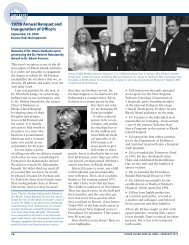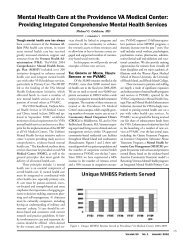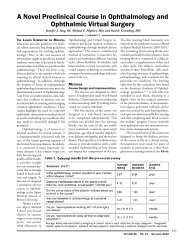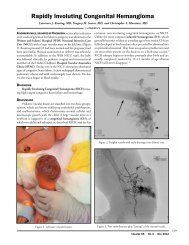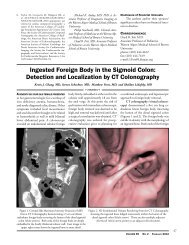Hyperuricemia & Gout - Rhode Island Medical Society
Hyperuricemia & Gout - Rhode Island Medical Society
Hyperuricemia & Gout - Rhode Island Medical Society
Create successful ePaper yourself
Turn your PDF publications into a flip-book with our unique Google optimized e-Paper software.
ten to ensure coordinated, uninterrupted flow of information<br />
and data that enables accurate monitoring, measurement<br />
and reporting, and unambiguous delineation of accountability<br />
for performance of each function. “Adequate resources,” at<br />
a minimum, means sufficient software and programming to<br />
relieve the staff of the mountains of paperwork involved in<br />
aggregating data from dissimilar and non-communicating<br />
databases to produce non-standardized, individualized reports<br />
to countless committees, managers and other publics. It also<br />
means providing funds for a dedicated position with Staff<br />
responsibility for oversight of the key aspects of performance<br />
measurement and improvement within the organization. This<br />
position should be viewed as similar to an internal auditor<br />
but with an expert level of familiarity with the tools of quality<br />
improvement and quality management. The authority to hold<br />
any group or individual at any level within the organization<br />
accountable for compliance with the established Performance<br />
Improvement Plan should be granted. Accountability and<br />
reporting should be to a top manager and/or the top Quality<br />
oversight body.<br />
The next most important activity is the provision of feedback,<br />
formatted to be useful to the target audience. This usually<br />
requires multiple revisions to reach a report that conveys<br />
the intended information to a large majority of the users. This<br />
is the reason for the data collection and analysis and performance<br />
measurement. Without the feedback of results, the<br />
collection and analysis activities are wasted.<br />
OTHER CONSIDERATIONS<br />
As one confronts new issues requiring improvement, the<br />
process designed is likely to include new work for someone. It<br />
may be a simple item for documentation. But, how long will it<br />
really take? How inconvenient is it within the existing workflow<br />
of the provider? Is it truly “simple” to do or is it going to place<br />
additional stress on individuals who already struggle to meet all<br />
the demands placed on their time? Will this “last straw” force a<br />
decision to trade one task for another or as a last resort, since<br />
documentation is audited, to supply false documentation? Don’t<br />
forget the relationship between workload and performance as<br />
one approaches capacity for added duties. It may require a<br />
work analysis prior to process implementation.<br />
Prudent direct observation of how a process is actually<br />
being performed is often dropped from consideration since it<br />
can embarrass the observer and is perceived to demean the<br />
observed. None-the-less, this is an important function within<br />
the performance management program. Familiar examples are<br />
anonymous observation of hand-washing and use of a disclosing<br />
compound to measure housekeeping effectiveness. Some<br />
activities, such as pre-operative protocols to prevent wrong site<br />
surgery, are too important to leave any doubt as to whether<br />
there is 100% compliance. Documentation is not the same as<br />
witnessing it happen.<br />
Don’t forget the characteristics of memory that should influence<br />
planning for training and retraining. The simple rule<br />
is, the amount learned depends on the time spent learning. 4<br />
This, of course, is impacted by the quality of the teaching provided<br />
and how well accelerated learning techniques can be<br />
applied. Also to be incorporated in the planning is the reality<br />
that there is a rapid loss of material that has been learned. The<br />
frequency of retraining is modified by the complexity of the<br />
process design, the critical rating of the process or procedure,<br />
and the frequency the task is performed.<br />
CONCLUSION<br />
No professional wishes to affiliate with an institution that<br />
is not committed to achieving and maintaining a high level of<br />
performance. Mediocre performance demeans the provider<br />
and inevitably results in patient harm and wasted resources.<br />
Prevention of relapse in performance levels requires planning,<br />
persistence and a reward structure that promotes performance<br />
advances. Inattention will result in frustration and rework that<br />
competes with new initiatives. The energy devoted to maintaining<br />
improvement levels should be valued as equally satisfying<br />
and beneficial to patients as efforts given to new improvement<br />
projects. It requires both to produce a high level of performance<br />
throughout the institution.<br />
REFERENCES<br />
1. Beck C, et al. Sustaining a best-care practice in a nursing home. J Healthcare<br />
Quality 2005;27:5-16.<br />
2. Leatherman S, et al. The business case for quality. Health Affairs 2003; 22:17-<br />
30.<br />
3. Milstein A. Ending extra payment for “never events.” NEJM 2009;360:2388-<br />
90.<br />
4. Ebbinghaus H. Memory: A Contribution to Experimental Psychology. New<br />
York City: Teachers College, Columbia University; 1913.<br />
John S. Coldiron, MD, MPH, is Vice President, <strong>Medical</strong><br />
Management Insight Health Solutions.<br />
Disclosure of Financial Interests<br />
The author has no financial interests to disclose.<br />
CORRESPONDENCE<br />
John S. Coldiron, MD, MPH<br />
Insight Health Solutions<br />
2377 Pawtucket Avenue<br />
East Providence, RI 02914<br />
phone: (866) 743-9481<br />
e-mail: jcoldiron@insighthealthsolutions.com<br />
VOLUME 92 NO. 11 NOVEMBER 2009<br />
383




